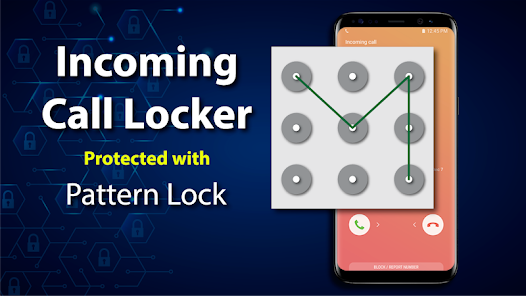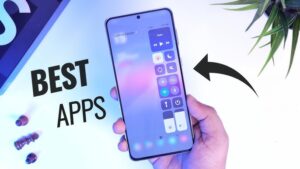Incoming Call Lock: Enhancing Privacy and Security on Mobile Devices
In today’s digital age, privacy and security have become paramount concerns for mobile users. With the constant flow of information through calls, texts, and apps, maintaining control over who accesses your phone, especially during an incoming call, is vital. The concept of an “incoming call lock” has emerged as a smart solution to prevent unauthorized access during a phone call. This article will delve into what an incoming call lock is, why it’s necessary, and how it enhances both privacy and security on mobile devices.
An incoming call lock is a feature or application that restricts access to a phone during an active or incoming call. Typically, when a call comes in, the phone’s screen is automatically activated, allowing anyone near the device to interact with it—whether to answer, reject, or even access other sensitive parts of the phone.
DOWNLOAD NOW :-
App Link
But usually by clicking on the download button above you will be connected to another page and from there you will see a button that will reload very easily in 15 seconds and by clicking on that button it will take 15 seconds for you to load the application and it will be correct in our play store. And the application is very easy to use but once downloaded I am going to explain you below the steps to be followed read fully to understand
What is an Incoming Call Lock?
With an incoming call lock, you can set a password, PIN, or biometric lock (such as fingerprint or face recognition) that restricts access to the call screen. Only authorized users can answer or dismiss the call. This feature is especially useful in preventing unwanted people from picking up your phone and answering calls without your permission.
Why is an Incoming Call Lock Important?
- Privacy Protection
Incoming calls often contain personal or business-related conversations that are not meant for others. Having an incoming call lock ensures that only you or a trusted individual can answer the call. This is particularly important if your phone is left unattended in a public space or within a group of people. - Prevention of Accidental Calls
Sometimes, incoming calls may be accidentally answered or rejected if the phone is in a pocket, bag, or simply lying on a surface. With a lock in place, accidental taps or swipes are prevented, reducing the chances of missed calls or unwanted interruptions. - Blocking Unwanted Access
If your phone is lost or stolen, an incoming call lock can prevent unauthorized individuals from answering calls or interacting with the phone’s call screen. This adds an extra layer of security, especially if the incoming call contains sensitive information. - Protection for Children’s Devices
Many parents prefer to give their children phones for communication purposes but are worried about inappropriate access. An incoming call lock ensures that children only answer calls from trusted contacts and prevents them from interacting with unknown numbers.
How to Set Up Incoming Call Lock on Different Devices
On Android Phones
Several Android phones come with built-in features that allow users to set a lock on incoming calls. Additionally, there are third-party apps available in the Play Store that offer more robust control over call security.
- Using Phone Settings:
Navigate to your phone’s security settings and enable a screen lock that requires authentication before answering calls. Some models may provide direct options for enabling locks specifically for the call screen. - Using Third-Party Apps:
Apps like Call Lock, Call Blocker, or Incoming Call Lock offer features that allow you to customize the lock for incoming calls. These apps may also provide features like blocking unknown numbers or creating a whitelist for trusted contacts.
On iPhones
Although iOS doesn’t provide a direct incoming call lock feature like Android, users can still implement privacy settings to secure their calls.
- Face ID/Touch ID Security:
iPhones rely on biometric security like Face ID or Touch ID to lock and unlock the screen. While receiving a call, these security features can prevent unauthorized access to the call interface. - Third-Party Solutions:
iPhones may not have as many third-party options as Android, but there are some call blocking apps that help restrict access to incoming calls, particularly from unknown or suspicious numbers.
Best Practices for Using Incoming Call Lock
- Enable Biometric Security
Biometric options such as fingerprint or facial recognition provide the most seamless way of securing incoming calls. These methods are not only fast but also highly secure, as they are unique to the individual user. - Set Up Trusted Contacts
Some phones allow users to configure trusted contacts whose calls will bypass the incoming call lock. This feature ensures that important calls from family or emergency contacts are never missed, even when security measures are enabled. - Use Strong Passwords
If biometric security isn’t an option, make sure to use a strong password or PIN that isn’t easily guessed. Avoid common combinations like 1234 or personal information like your birthdate as part of your security setup. - Regularly Update Security Settings
With every software update, new security features are introduced, including those for managing incoming call locks. Ensure that your phone is updated with the latest firmware to take advantage of new features and maintain strong security protocols.
Conclusion
In an era where privacy and security are constantly under threat, locking incoming calls is a simple yet effective way to maintain control over who has access to your phone during crucial moments. Whether you’re using a built-in feature or a third-party app, implementing an incoming call lock adds a valuable layer of protection. By keeping your calls private and secure, you can safeguard sensitive conversations and prevent unauthorized access.




















